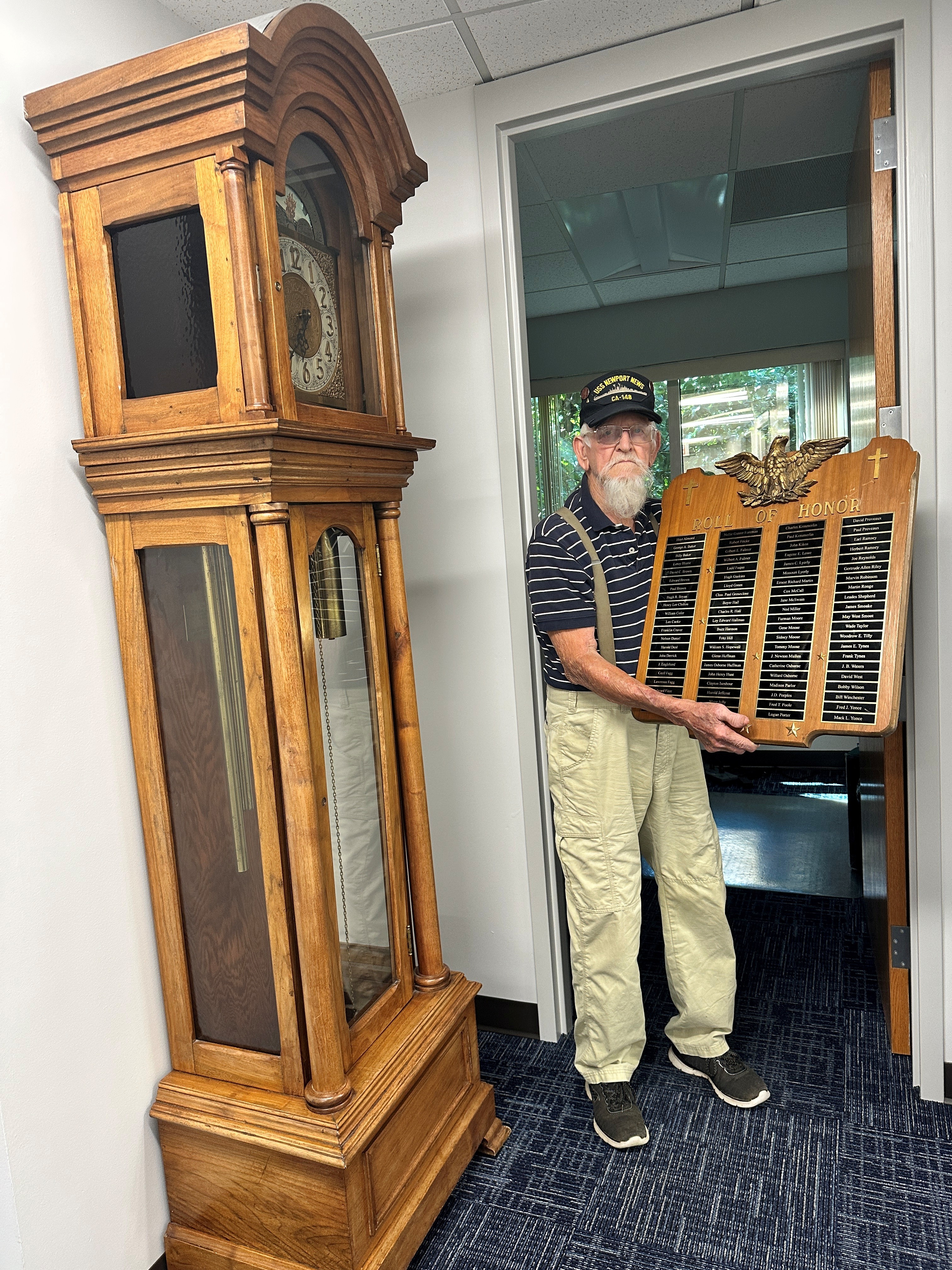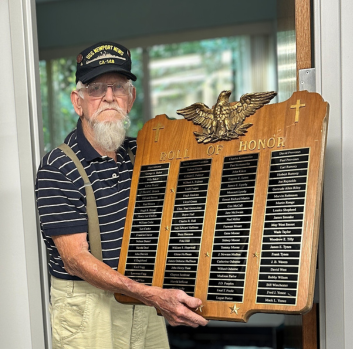By Cindy Adams

Seven decades have passed since Noah Foley left the Lutheran Children’s Home of the South. He arrived when he was 11 and departed at 18, moving from the young boys’ cottage to the older boys’ cottage as he matured during those seven years. The girls had similar cottages with age-related expectations. With 120 children on campus, their shared work, recreation, education and circumstances forged bonds that endure today.
Noah lived at the Children’s Home from 1947-1954. His days started at 4:30 a.m. with morning chores on a full farm: mowing yards, milking cows, feeding pigs, bundling hay, gathering eggs, and harvesting tomatoes, peas, beans and strawberries from a three-acre garden. Breakfast was at 7 a.m. and the school bus arrived at 8 a.m.
His first introduction to farm life was cutting six acres of grass with an old push mower. They were not gasoline-powered at the time, so he explained how two boys pushed the mower and the other guided it.
"We also milked 16-18 cows every morning and every night," Noah said. "At first, by hand, then we got an electric milker, and a year later, a pasteurizer."
He also recalls their farm manager winning a county fair award for growing 192 bushels of corn in one acre. The children sustained themselves with their harvest, supplemented by donations from Lutheran congregations. When mealtime came, a large bell summoned them to the dining hall: young girls first, then older girls, followed by young boys, then older boys. Despite their hunger, order prevailed.
From 7-9 p.m., they did homework, then went to bed. The cycle repeated daily. Each cottage had a house mother maintaining the schedule. Girls handled kitchen duties – prep, cooking and cleaning – while everyone cleaned their cottages. With such demanding days, there were no complaints when bedtime arrived.
While they worked hard, there was time set aside for recreation. Their fun included riding bikes, playing games, building models and occasional movie trips. Noah fondly remembers swimming and rides at Lakeside Amusement Park in Salem.
"That was a really big deal," he said. "We just had to say we were from the Lutheran Children's Home, and they would let us right on the rides. I've always been thankful for that."
While Noah doesn't recall overt tenderness or affection, he would have chosen the Children's Home over returning to his previous situation.
"They fed us three meals a day and kept us in line," Noah said. "A good talking-to was worse than a whipping for me. If you deserved a whipping, Superintendent Rohrbaugh would be sure to lay one on you, but I never got one."
Compassion took many forms. Though strict, Rohrbaugh responded when Noah, or any of the boys, needed something like shoes. All they had to do was ask. Noah said the Children’s Home leaders brought structure and discipline into his life, and he counts that as a great gift.
"If it were not for them, I wouldn’t be here. I would have gone down the wrong road," he said. "The Home was a second parent, teaching me better ways."
At 18, Noah aged out of the Home and a couple of years later he joined the military.
"I was in the Navy for three years, 10 months and 22 days," Noah said. "I was ready to get out. I got a speeding ticket coming home!"
After military service, he returned to Roanoke, living with his sister until marrying in 1962. He and his wife became pivotal in organizing Children's Home reunions. Noah was later elected Alumni Association President. Now 89, he still carries the Bible given to him during his Lutheran confirmation in the 1950s while living at the Children's Home.
"We were misfortunate, but entering the home made us fortunate," Noah said."At the time, I didn't think it was good, but looking back, it’s the sweetest thing that ever happened."
"Among the more than 1,000 alumni of the Home, there are ministers, lawyers, doctors, students, florists, teachers, nurses, printers, farmers, millworkers, clerks, machinists, mechanics, businessmen, service men, home makers, etc. …"
Taken from The Lutheran Children's Home of the South, 1888-1963, Seventy-Five Years of Service
*Grandfather clock retained from the Children's Home. Plaque recognizes people from the Children's Home who served in World War II. Stars denote those who were killed in the war.
EPILOGUE:
Lutheran Children's Home faced many crossroads. Ninth Superintendent T.C. Rohrbaugh divided the institution's history into periods, starting from its founding to 1927, as a time when the home was struggling for its existence. He marks the second period, from 1927-1957, as a reckoning with economic depression and a World War; and the third, 1957-1963, as adaptation to new conditions. The fourth period, ending with what they called a "Century of Caring," focused on navigating new childcare concepts within a more complex society.
To illustrate, at one time children shared a communal clothes closet. Each morning, clean clothes were placed on a table and the children picked out their daily attire. This changed to a more personal practice through which children possessed their own clothes. Similarly, boys once received mass haircuts at regular intervals. They marched to the barber together, all received "G.I. style" haircuts, and marched home together. The new approach allowed boys individual barbershop visits like their peers. Both boys and girls also stopped going through the school cafeteria as a group, another effort to respect the individuality of each child.
The Children's Home also began an effort to keep children in personal or foster homes, rather than an institutional environment, through a financial support program they called "Mother’s Aid." The leaders also turned attention and resources to the larger family as societal pressures caused breakdowns in this structure.
The shift from a Children's Home to a larger, more comprehensive agency was on the horizon as leaders began looking at program expansion and decentralization. Their direction was to begin establishing group homes, broadening the Minnick Education Center, expanding Foster Care and beginning family-based services. To accomplish this, Lutheran Family Services of Virginia was formed in 1984. They felt this name better described their expanding services. The first recommendation was that Lutheran Family Services of Virginia should "continue to be flexible, creative and innovative in addressing human need."
Today, the organization operates as enCircle, another name change to better reflect an even larger vision. Still, enCircle strives to carry out the same earlier call to be flexible, creative, innovative and inclusive in meeting children, family and community needs.
"This organization began in the tradition of compassion, kindness and inclusion and we’ve grown by maintaining that care amid evolving needs. We still look through the lens of love," said Ray Ratke, enCircle’s CEO.
What started in 1888 was a heartfelt desire to care for children in need. That hasn’t changed. The mission circle has simply widened. Today, we continue our legacy of helping make the world a more loving place.
References:
The Lutheran Children’s Home of the South, 1888-1963, Seventy-Five Years of Service.
The Lutheran Children’s Home of the South, 1963-1988, Challenge and Change


